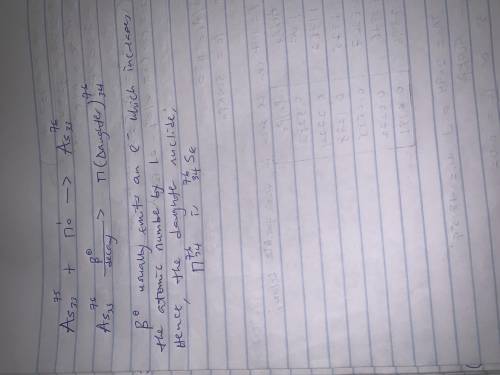
Chemistry, 22.04.2020 01:32 Clervoyantyvonne
It is desired to determine the concentration of arsenic in a lake sediment sample by means of neutron activation analysis. The nuclide captures a neutron to form , which in turn undergoes β decay. The daughter nuclide produces the characteristic γ rays used for the analysis. What is the daughter nuclide?

Answers: 1
Another question on Chemistry

Chemistry, 21.06.2019 21:00
Read these sentences from the text. near the equator, the tropics receive the most rain on a consistent basis. as a result, the fresh water falling into the ocean decrease the salinity of the surface water in that region. [. .] . . as the salt content of sea water increases, so does its density. what can you infer about how rain affects the density of surface water near the equator?
Answers: 1

Chemistry, 22.06.2019 09:20
What happened to the amount of carbon dioxide in the atmosphere from 2010–2017?
Answers: 1

Chemistry, 22.06.2019 10:00
3. how much energy in joules is required to evaporate .0005 kg of liquid ammonia to vapor at the same temperature? 4. how much energy ( in megajoules ) is given up by .75 kg of water at 0c when it freezes to form ice at 0c? 5. explain how heat works between and at critical temperatures?
Answers: 2

Chemistry, 22.06.2019 17:40
How much heat is added if 0.814g of water increase in temperature by 0.351 degree c?
Answers: 3
You know the right answer?
It is desired to determine the concentration of arsenic in a lake sediment sample by means of neutro...
Questions








Chemistry, 12.04.2021 21:40





Mathematics, 12.04.2021 21:40


History, 12.04.2021 21:40


Arts, 12.04.2021 21:40






